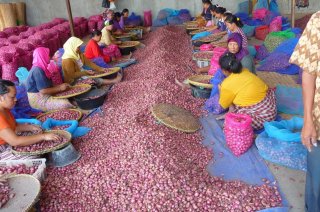
Methodology
Gridded information on soils and climate was combined with specific shallot requirements to identify the suitability of areas for TSS systems across Indonesia.
Based on this mapping, grid cells were identified that are suitable for TSS systems. A map of cropland areas was used as a mask to limit this suitability to those grid cells that currently are under cultivation.
The following spatial databases were used in the analyses:
- Historical weather data are from the Climate Research Unit of the University of East Anglia. Here, we use the dataset CRU TS v. 3.23 which has a spatial resolution of 30x30 arc minutes, about 55x55 km near the equator, and a temporal resolution that covers each month in the period 1981 – 2010 (30 years). This dataset comprises monthly values of cloud cover, temperature, diurnal temperature range, vapour pressure, rainfall, and the number of rain days.
- Soil data are based on the Harmonized World Soil Database (HWSD v1.21) with a spatial resolution of about 1 km2 near the equator. Soil properties of the top soil (0-30 cm) were selected for the suitability analyses and comprise: (1) clay content, (2) pH and (3) soil organic carbon content. Soil organic matter content (SOM) was calculated by dividing soil organic carbon content by 0.58.
- Terrain slope class and elevation maps are used to assess suitability with respect to slope conditions and altitude (HWSD v1.21).
- A spatial cropland distribution map, i.e. cropland extent as fraction of grid cell area, is used to distinguish between arable and non-arable areas (Fritz et al, 2015).
